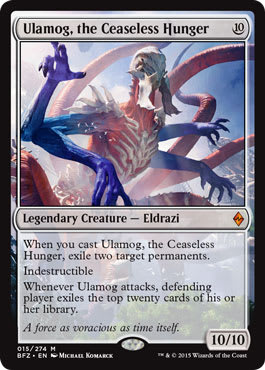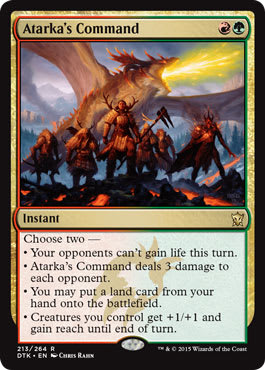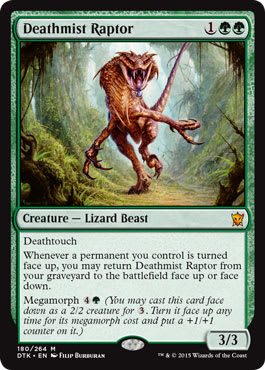It’s here! It’s here! Last weekend, Wizards of the Coast released the full spoiler for Shadows over Innistrad, and I feel like a little girl on Christmas morning.
Each time a Standard rotation occurs, there’s a sort of electricity that you can feel coursing through the Magic corners of the Internet. All kinds of things are possible, and anything could be printed in a new set. Each week of spoilers feels almost like the countdown to start a race.
When preparing a deck for a brand new Standard format, it is crucial to fall within one of two strategies:
- Have cards that can reliably answer as many different kinds of threats as possible.
- Be as streamlined as possible.
Any easy trap to fall into is to play piles and piles of powerful, albeit narrow, new answers and removal spells in each set. Sure, Nahiri, the Harbinger is a powerful Magic card, but is she really that efficient? A 4-mana conditional removal spell that will often just die the turn after it’s cast isn’t the best place to be. Conversely, playing Anguished Unmaking is pretty reasonable. It’s near-unconditional and mana-efficient, and it has uses against most archetypes.
On the other side of the coin, it is also easy to try to add a bunch of fluff to decks that want to be proactive. Void Winnower is great, and as a white girl, I enjoy a literally-can’t-even joke as much as the next person, but it may not be the best option for a ramp deck that can play threats that are better at closing a game. Looking at similar spots on the curve for ramp strategies, there are other options in Dragonlord Atarka and Ulamog, the Ceaseless Hunger that stabilize the board in addition to being enormous threats.
Many players tend to try to port decks over from the rotating Standard format, and this doesn’t always work. Take the following Atarka Red deck for example:
Atarka Red ? Oath of the Gatewatch Standard | Korey McDuffie, 1st Place, Star City Games Standard Open, 1/23/16
- Lands (22)
- 1 Forest
- 11 Mountain
- 2 Cinder Glade
- 4 Bloodstained Mire
- 4 Wooded Foothills
- Creatures (14)
- 4 Abbot of Keral Keep
- 4 Monastery Swiftspear
- 3 Reckless Bushwhacker
- 3 Zurgo Bellstriker
- Spells (24)
- 4 Atarka's Command
- 2 Become Immense
- 3 Fiery Impulse
- 4 Titan's Strength
- 4 Wild Slash
- 4 Dragon Fodder
- 3 Hordeling Outburst
- Sideboard (15)
- 2 Den Protector
- 2 Pia and Kiran Nalaar
- 3 Arc Lightning
- 2 Painful Truths
- 4 Self-Inflicted Wound
- 2 Smoldering Marsh
Despite having some innovative card choices in this deck (the black cards out of the sideboard were particularly new to the archetype), the deck itself was the quintessential aggressive red deck of last format. Porting this to Shadows over Innistrad Standard may not be doable. This is a Red Deck Wins variant that had so many interlocking synergies, and losing the handful of rotating cards may end up putting the proverbial nail in the coffin.
To summarize, here are some things that won’t be possible post-rotation:
- Fetch lands allowing the deck to cheat on how many green lands it has to play for Atarka's Command
- Hordeling Outburst padding the number of creatures in play to use with Reckless Bushwhacker and Atarka's Command
- The go-wide strategy (swarming the board with several small creatures) that lends itself so well to pump spells becomes much weaker without Hordeling Outburst.
- Without the fetch lands, it will be very hard to have the transformation into a Jund deck post-sideboard. There were effectively ten sources of black (between fetches and the pair of Smoldering Marshes) that only occupied two sideboard slots.
- Monastery Swiftspear’s ability to translate into the late game in a way that most red 1-drop creatures cannot. The fact that Swiftspear with Titan's Strength “builds” a 5/4 creature on the second turn is amazing. This effect is near-irreplaceable and will be sorely missed.
This is just the start of a laundry list of things that shows why porting decks from one format to another does not always work. Context is incredibly important. Looking to other archetypes that have a bit of a head start this format (as far as brewing is concerned), we can turn to Andy Ferguson’s Bant Company:
Bant Company ? Oath of the Gatewatch Standard | Andy Ferguson, 2nd place Star City Games Open, 1/30/16
- Lands (25)
- 2 Forest
- 1 Island
- 3 Plains
- 2 Canopy Vista
- 4 Flooded Strand
- 4 Lumbering Falls
- 2 Prairie Stream
- 4 Windswept Heath
- 1 Wooded Foothills
- 2 Yavimaya Coast
- Creatures (25)
- 4 Bounding Krasis
- 4 Deathmist Raptor
- 4 Den Protector
- 4 Reflector Mage
- 4 Sylvan Advocate
- 4 Jace, Vryn's Prodigy
- 1 Warden of the First Tree
- Spells (10)
- 4 Collected Company
- 4 Dromoka's Command
- 2 Ojutai's Command
- Sideboard (15)
- 4 Arashin Cleric
- 2 Frost Walker
- 1 Harbinger of the Tides
- 1 Silkwrap
- 3 Disdainful Stroke
- 3 Dispel
- 1 Valorous Stance
This is an example of a deck that is incredibly streamlined and that is playing versatile answers to cards that may or may now show up in a format. Outside of the mana base, only eleven cards rotate out of Standard, and ten of those are in the sideboard! This doesn’t necessarily show how strong this archetype will be in the context of post-rotation Standard, but it does at least instill a bit of confidence in the deck itself.
Going forward, there are a few different takes on this archetype depending on what the deck’s pilot wants to be prepared for. The first is probably going to be the first place I turn to in the upcoming format. It falls under the aforementioned as-streamlined-as-possible school of thinking from earlier and is just trying to do what it can to loop as many copies of Collected Company and Deathmist Raptor as possible (without dying).
Streamlined Bant Company Megamorph ? Shadows over Innistrad Standard | Emma Handy
- Lands (24)
- 4 Lumbering Falls
- 4 Yavimaya Coast
- 3 Evolving Wilds
- 2 Island
- 1 Plains
- 3 Forest
- 3 Canopy Vista
- 2 Prairie Stream
- 2 Fortified Village
- Creatures (28)
- 4 Jace, Vryn's Prodigy
- 4 Sylvan Advocate
- 4 Deathmist Raptor
- 4 Den Protector
- 3 Stratus Dancer
- 3 Eldrazi Skyspawner
- 4 Reflector Mage
- 2 Archangel Avacyn
- Spells (8)
- 4 Collected Company
- 4 Dromoka's Command
- Sideboard (15)
- 2 Negate
- 2 Dispel
- 3 Silkwrap
- 3 Lantern Scout
- 2 Eerie Interlude
- 1 Westvale Abbey
- 1 Archangel Avacyn
- 1 Hidden Dragonslayer
This take on the deck seems to fall a bit under the slave-to-your-theme category—meaning that it focuses a bit too much on a certain aspect of the archetype (in this case, the megamorph package), and as a result, the deck itself suffers.
After testing this archetype with other Team Bolas members, the flaws in this deck became quite apparent. There are entirely too many 3-drops in the deck, and it’s easy to be overrun by aggressive strategies—especially ones that include flyers. On the other side of the coin, this deck has a lot of trouble against decks that play multiple sweepers are good at clogging up the ground. This mostly included decks with Dragonlord Ojutai or U/B Control decks.
On the other hand, this decklist felt incredibly well-suited to take down any type of midrange strategies that pop up at the beginning of a format. Between Collected Company, Jace, Vryn's Prodigy, Deathmist Raptor, and Den Protector, there’s a nearly endless source of onboard card advantage that can translate into killing to opponent very quickly. There are some games in which it just lost to its mana or to poor draws (this is Magic, after all), but the overall win percentage of this deck against anything playing “in the middle” (read “neither dedicated aggro nor dedicated control”) was in the eighty-percent range over the weekend.
Building a version of the deck in which Deathmist Raptor is a bit less focal while being a bit closer to Andy’s original take on the archetype is the next phase of evolution in the archetype. Deathmist Raptor is a great card in the deck and doesn’t necessarily need to come out. That being said, many of the megamorph creatures are actually 5-drops in disguise mixed with some sort of “consolation prize” on Collected Company that isn’t actually a whiff—but getting 2/1s with evasion is hardly the reason Collected Company has entire archetypes named after it.
The next step in the deck that I’ll be taking with Bant Company moves the curve a little bit lower, pays a bit more respect to other Collected Company decks, and has more Planeswalkers against the control archetypes of the format. If the first take on the deck fell under the Streamlined category, this one is much closer to the Versatile Answers school of thinking.
Versatile Bant Company ? Shadows over Innistrad Standard | Emma Handy
- Lands (24)
- 4 Lumbering Falls
- 4 Yavimaya Coast
- 3 Evolving Wilds
- 2 Island
- 1 Plains
- 3 Forest
- 3 Canopy Vista
- 2 Prairie Stream
- 2 Fortified Village
- Creatures (28)
- 4 Jace, Vryn's Prodigy
- 4 Sylvan Advocate
- 3 Elvish Visionary
- 3 Eldrazi Skyspawner
- 3 Den Protector
- 4 Deathmist Raptor
- 4 Reflector Mage
- 1 Nissa, Vastwood Seer
- 2 Archangel Avacyn
- Spells (8)
- 4 Collected Company
- 4 Dromoka's Command
- Sideboard (15)
- 1 Archangel Avacyn
- 2 Stratus Dancer
- 2 Negate
- 2 Clip Wings
- 2 Hallowed Moonlight
- 1 Kiora, Master of the Depths
- 3 Lantern Scout
- 2 Silkwrap
The changes from one deck to the other are relatively minute but make a world of difference in a deck that is able to sift through so many cards in any given game. The only changes to the main deck are cutting Stratus Dancers for copies of Elvish Visionary and shaving a Den Protector for one copy of Nissa, Vastwood Seer.
The real changes are in the sideboard. The Hallowed Moonlights were originally something that many players had taken out of their playable Standard cards with the rotation of Rally the Ancestors, but the card has a large number of applications against Collected Company, Deathmist Raptors, Ever After, and Necromantic Summons (spoiler alert: Michael Majors might have been on to something with U/B Reanimator), and it even has splash applications against decks that produce multiple tokens simultaneously.
Clip Wings is a concession to this deck having a good bit of trouble against opposing copies of Archangel Avacyn and Dragonlord Ojutai, with minor uses against other cards. Getting around Avacyn’s indestructible clause is just icing on the cake.
The inclusion of Stratus Dancers in the ’board is a small admission that, despite clogging up the main deck in several matchups, the card still has a lot of staying power against slower decks. With the built-in card advantage it provides, Stratus Dancer becomes nearly impossible to ignore against the decks packing Languish, Avacyn’s Judgment, and Planar Outburst. There’s a strong change that there are too many conditional counterspells out of the sideboard, but in testing, it is better to play several different styles of similar effects in order to see which cards are better than others with a smaller sample size.
Kiora, Master of the Depths is a Planeswalker that fell off a bit shortly after Battle for Zendikar was printed, but with Den Protector and Deathmist Raptor in the deck, this may be the shell that she really shines in. Upping the curve makes it incredibly tempting to put the Westvale Abbey back in the sideboard, but for now, this seems to be fine on mana.
Lantern Scout’s spot as the “go-to” red-deck-hate card merits at least a bit of explanation. I am of the impression that the Scout will be much more important going forward than it was in the previous Standard format against various aggressive strategies. Last format, there were multiple decks that were using a combination of Become Immense and Temur Battle Rage to deal absurd amounts of damage within a single turn, and they forced decks to stay on the defensive for a large portion of the game.
When players are forced into staying on defense for long durations in a game, cards with lifelink (on the defensive player’s turn) aren’t nearly as beneficial as they would be under normal circumstances. There were times a player would cast Lantern Scout, attack for 8, and die the following turn when an Abbot of Keral Keep crashed in for 20 points of damage (with trample to boot!). Without such huge swings coming from the red deck this format, it seems that Lantern Scout may have his time to shine in a deck as dedicated to filling the board with creatures as Bant Company.
With all of the new cards that have been spoiled, make sure to tune in next week when I go over some overlooked cards that have a chance to shine, a handful of fresh brews, and possibly an update on an old archetype. In the meantime, drop a comment below with some of your favorite new cards or any decks you’d like helping hand with—or if you just want to show off your newest idea for the upcoming Standard format!


























